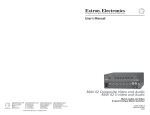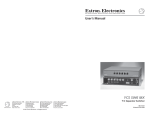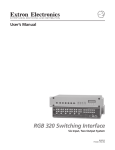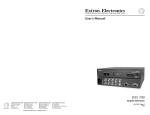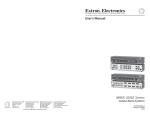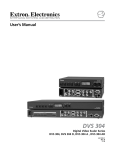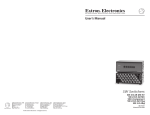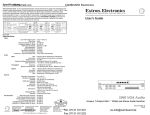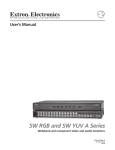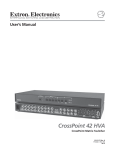Download Extron electronics SW6 User`s manual
Transcript
User’s Manual Audio/Video Switchers SW6 AV MX SW6 AV MX AS SW6 CV MX SW6 CV MX AS SW6 SA MX SW6 SV MX SW6 SV MX AS SW6 SV A MX SW6 SV A MX Auto www.extron.com Extron Electronics, USA Extron Electronics, Europe Extron Electronics, Asia Extron Electronics, Japan 1230 South Lewis Street Anaheim, CA 92805 USA 714.491.1500 Fax 714.491.1517 Beeldschermweg 6C 3821 AH Amersfoort The Netherlands +31.33.453.4040 Fax +31.33.453.4050 135 Joo Seng Road, #04-01 PM Industrial Building Singapore 368363 +65.6383.4400 Fax +65.6383.4664 Daisan DMJ Building 6F 3-9-1 Kudan Minami Chiyoda-ku, Tokyo 102-0074 Japan +81.3.3511.7655 Fax +81.3.3511.7656 © 2002 Extron Electronics. All rights reserved. 68-293-01 Printed in the USA Precautions Safety Instructions • English This symbol is intended to alert the user of important operating and maintenance (servicing) instructions in the literature provided with the equipment. This symbol is intended to alert the user of the presence of uninsulated dangerous voltage within the product's enclosure that may present a risk of electric shock. Caution Read Instructions • Read and understand all safety and operating instructions before using the equipment. Retain Instructions • The safety instructions should be kept for future reference. Follow Warnings • Follow all warnings and instructions marked on the equipment or in the user information. Avoid Attachments • Do not use tools or attachments that are not recommended by the equipment manufacturer because they may be hazardous. Consignes de Sécurité • Français Ce symbole sert à avertir l’utilisateur que la documentation fournie avec le matériel contient des instructions importantes concernant l’exploitation et la maintenance (réparation). Ce symbole sert à avertir l’utilisateur de la présence dans le boîtier de l’appareil de tensions dangereuses non isolées posant des risques d’électrocution. Attention Lire les instructions• Prendre connaissance de toutes les consignes de sécurité et d’exploitation avant d’utiliser le matériel. Conserver les instructions• Ranger les consignes de sécurité afin de pouvoir les consulter à l’avenir. Respecter les avertissements • Observer tous les avertissements et consignes marqués sur le matériel ou présentés dans la documentation utilisateur. Eviter les pièces de fixation • Ne pas utiliser de pièces de fixation ni d’outils non recommandés par le fabricant du matériel car cela risquerait de poser certains dangers. Sicherheitsanleitungen • Deutsch Dieses Symbol soll dem Benutzer in der im Lieferumfang enthaltenen Dokumentation besonders wichtige Hinweise zur Bedienung und Wartung (Instandhaltung) geben. Dieses Symbol soll den Benutzer darauf aufmerksam machen, daß im Inneren des Gehäuses dieses Produktes gefährliche Spannungen, die nicht isoliert sind und die einen elektrischen Schock verursachen können, herrschen. Achtung Lesen der Anleitungen • Bevor Sie das Gerät zum ersten Mal verwenden, sollten Sie alle Sicherheits-und Bedienungsanleitungen genau durchlesen und verstehen. Aufbewahren der Anleitungen • Die Hinweise zur elektrischen Sicherheit des Produktes sollten Sie aufbewahren, damit Sie im Bedarfsfall darauf zurückgreifen können. Befolgen der Warnhinweise • Befolgen Sie alle Warnhinweise und Anleitungen auf dem Gerät oder in der Benutzerdokumentation. Keine Zusatzgeräte • Verwenden Sie keine Werkzeuge oder Zusatzgeräte, die nicht ausdrücklich vom Hersteller empfohlen wurden, da diese eine Gefahrenquelle darstellen können. Instrucciones de seguridad • Español Este símbolo se utiliza para advertir al usuario sobre instrucciones importantes de operación y mantenimiento (o cambio de partes) que se desean destacar en el contenido de la documentación suministrada con los equipos. Este símbolo se utiliza para advertir al usuario sobre la presencia de elementos con voltaje peligroso sin protección aislante, que puedan encontrarse dentro de la caja o alojamiento del producto, y que puedan representar riesgo de electrocución. Precaucion Leer las instrucciones • Leer y analizar todas las instrucciones de operación y seguridad, antes de usar el equipo. Conservar las instrucciones • Conservar las instrucciones de seguridad para futura consulta. Obedecer las advertencias • Todas las advertencias e instrucciones marcadas en el equipo o en la documentación del usuario, deben ser obedecidas. Evitar el uso de accesorios • No usar herramientas o accesorios que no sean especificamente recomendados por el fabricante, ya que podrian implicar riesgos. Extron’s Warranty Warning Power sources • This equipment should be operated only from the power source indicated on the product. This equipment is intended to be used with a main power system with a grounded (neutral) conductor. The third (grounding) pin is a safety feature, do not attempt to bypass or disable it. Power disconnection • To remove power from the equipment safely, remove all power cords from the rear of the equipment, or the desktop power module (if detachable), or from the power source receptacle (wall plug). Power cord protection • Power cords should be routed so that they are not likely to be stepped on or pinched by items placed upon or against them. Servicing • Refer all servicing to qualified service personnel. There are no userserviceable parts inside. To prevent the risk of shock, do not attempt to service this equipment yourself because opening or removing covers may expose you to dangerous voltage or other hazards. Slots and openings • If the equipment has slots or holes in the enclosure, these are provided to prevent overheating of sensitive components inside. These openings must never be blocked by other objects. Lithium battery • There is a danger of explosion if battery is incorrectly replaced. Replace it only with the same or equivalent type recommended by the manufacturer. Dispose of used batteries according to the manufacturer's instructions. Avertissement Alimentations• Ne faire fonctionner ce matériel qu’avec la source d’alimentation indiquée sur l’appareil. Ce matériel doit être utilisé avec une alimentation principale comportant un fil de terre (neutre). Le troisième contact (de mise à la terre) constitue un dispositif de sécurité : n’essayez pas de la contourner ni de la désactiver. Déconnexion de l’alimentation• Pour mettre le matériel hors tension sans danger, déconnectez tous les cordons d’alimentation de l’arrière de l’appareil ou du module d’alimentation de bureau (s’il est amovible) ou encore de la prise secteur. Protection du cordon d’alimentation • Acheminer les cordons d’alimentation de manière à ce que personne ne risque de marcher dessus et à ce qu’ils ne soient pas écrasés ou pincés par des objets. Réparation-maintenance • Faire exécuter toutes les interventions de réparationmaintenance par un technicien qualifié. Aucun des éléments internes ne peut être réparé par l’utilisateur. Afin d’éviter tout danger d’électrocution, l’utilisateur ne doit pas essayer de procéder lui-même à ces opérations car l’ouverture ou le retrait des couvercles risquent de l’exposer à de hautes tensions et autres dangers. Fentes et orifices • Si le boîtier de l’appareil comporte des fentes ou des orifices, ceux-ci servent à empêcher les composants internes sensibles de surchauffer. Ces ouvertures ne doivent jamais être bloquées par des objets. Lithium Batterie • Il a danger d'explosion s'll y a remplacment incorrect de la batterie. Remplacer uniquement avec une batterie du meme type ou d'un ype equivalent recommande par le constructeur. Mettre au reut les batteries usagees conformement aux instructions du fabricant. Vorsicht Stromquellen • Dieses Gerät sollte nur über die auf dem Produkt angegebene Stromquelle betrieben werden. Dieses Gerät wurde für eine Verwendung mit einer Hauptstromleitung mit einem geerdeten (neutralen) Leiter konzipiert. Der dritte Kontakt ist für einen Erdanschluß, und stellt eine Sicherheitsfunktion dar. Diese sollte nicht umgangen oder außer Betrieb gesetzt werden. Stromunterbrechung • Um das Gerät auf sichere Weise vom Netz zu trennen, sollten Sie alle Netzkabel aus der Rückseite des Gerätes, aus der externen Stomversorgung (falls dies möglich ist) oder aus der Wandsteckdose ziehen. Schutz des Netzkabels • Netzkabel sollten stets so verlegt werden, daß sie nicht im Weg liegen und niemand darauf treten kann oder Objekte darauf- oder unmittelbar dagegengestellt werden können. Wartung • Alle Wartungsmaßnahmen sollten nur von qualifiziertem Servicepersonal durchgeführt werden. Die internen Komponenten des Gerätes sind wartungsfrei. Zur Vermeidung eines elektrischen Schocks versuchen Sie in keinem Fall, dieses Gerät selbst öffnen, da beim Entfernen der Abdeckungen die Gefahr eines elektrischen Schlags und/oder andere Gefahren bestehen. Schlitze und Öffnungen • Wenn das Gerät Schlitze oder Löcher im Gehäuse aufweist, dienen diese zur Vermeidung einer Überhitzung der empfindlichen Teile im Inneren. Diese Öffnungen dürfen niemals von anderen Objekten blockiert werden. Litium-Batterie • Explosionsgefahr, falls die Batterie nicht richtig ersetzt wird. Ersetzen Sie verbrauchte Batterien nur durch den gleichen oder einen vergleichbaren Batterietyp, der auch vom Hersteller empfohlen wird. Entsorgen Sie verbrauchte Batterien bitte gemäß den Herstelleranweisungen. Advertencia Alimentación eléctrica • Este equipo debe conectarse únicamente a la fuente/tipo de alimentación eléctrica indicada en el mismo. La alimentación eléctrica de este equipo debe provenir de un sistema de distribución general con conductor neutro a tierra. La tercera pata (puesta a tierra) es una medida de seguridad, no puentearia ni eliminaria. Desconexión de alimentación eléctrica • Para desconectar con seguridad la acometida de alimentación eléctrica al equipo, desenchufar todos los cables de alimentación en el panel trasero del equipo, o desenchufar el módulo de alimentación (si fuera independiente), o desenchufar el cable del receptáculo de la pared. Protección del cables de alimentación • Los cables de alimentación eléctrica se deben instalar en lugares donde no sean pisados ni apretados por objetos que se puedan apoyar sobre ellos. Reparaciones/mantenimiento • Solicitar siempre los servicios técnicos de personal calificado. En el interior no hay partes a las que el usuario deba acceder. Para evitar riesgo de electrocución, no intentar personalmente la reparación/ mantenimiento de este equipo, ya que al abrir o extraer las tapas puede quedar expuesto a voltajes peligrosos u otros riesgos. Ranuras y aberturas • Si el equipo posee ranuras o orificios en su caja/alojamiento, es para evitar el sobrecalientamiento de componentes internos sensibles. Estas aberturas nunca se deben obstruir con otros objetos. Batería de litio • Existe riesgo de explosión si esta batería se coloca en la posición incorrecta. Cambiar esta batería únicamente con el mismo tipo (o su equivalente) recomendado por el fabricante. Desachar las baterías usadas siguiendo las instrucciones del fabricante. Extron Electronics warrants this product against defects in materials and workmanship for a period of three years from the date of purchase. In the event of malfunction during the warranty period attributable directly to faulty workmanship and/or materials, Extron Electronics will, at its option, repair or replace said products or components, to whatever extent it shall deem necessary to restore said product to proper operating condition, provided that it is returned within the warranty period, with proof of purchase and description of malfunction to: USA, Canada, South America, and Central America: Extron Electronics 1230 South Lewis Street Anaheim, CA 92805, USA Europe, Africa, and the Middle East: Asia: Extron Electronics, Europe Beeldschermweg 6C 3821 AH Amersfoort The Netherlands Extron Electronics, Asia 135 Joo Seng Road, #04-01 PM Industrial Bldg. Singapore 368363 This Limited Warranty does not apply if the fault has been caused by misuse, improper handling care, electrical or mechanical abuse, abnormal operating conditions or non-Extron authorized modification to the product. If it has been determined that the product is defective, please call Extron and ask for an Applications Engineer at (714) 491-1500 (USA), 31.33.453.4040 (Europe), or 65.383.4400 (Asia) to receive an RA# (Return Authorization number). This will begin the repair process as quickly as possible. Units must be returned insured, with shipping charges prepaid. If not insured, you assume the risk of loss or damage during shipment. Returned units must include the serial number and a description of the problem, as well as the name of the person to contact in case there are any questions. Extron Electronics makes no further warranties either expressed or implied with respect to the product and its quality, performance, merchantability, or fitness for any particular use. In no event will Extron Electronics be liable for direct, indirect, or consequential damages resulting from any defect in this product even if Extron Electronics has been advised of such damage. Please note that laws vary from state to state and country to country, and that some provisions of this warranty may not apply to you. Table of Contents Chapter 1 • Introduction .......................................................... 1-1 About the Audio and Video Switchers ...................... 1-2 Features ...................................................................................... 1-2 S-video models ....................................................................... 1-3 Composite video models ....................................................... 1-3 Audio models ......................................................................... 1-3 Auto models ........................................................................... 1-4 All models .............................................................................. 1-4 Chapter 2 • Installation ............................................................. 2-1 Installation Overview .......................................................... 2-2 Mounting the switcher ....................................................... 2-2 Rear Panel Cabling ................................................................ 2-3 Power connection .................................................................. 2-3 Signal input connections ....................................................... 2-3 S-video models ....................................................................... 2-3 Composite video models ....................................................... 2-3 Audio models ......................................................................... 2-4 Signal output connections .................................................... 2-5 S-video models ....................................................................... 2-5 Composite video models ....................................................... 2-5 Audio models ......................................................................... 2-5 RS-232 or contact closure connection .................................. 2-5 External sync connection ....................................................... 2-6 Chapter 3 • Operation ................................................................ 3-1 Front Panel Controls and Indicators ............................ 3-2 Front Panel Operations ....................................................... 3-3 Selecting an input .................................................................. 3-4 Normal and auto-sync mode ................................................ 3-4 Viewing the current switch mode ........................................ 3-4 Selecting normal mode ......................................................... 3-4 Selecting auto-sync mode ..................................................... 3-4 Audio gain and attenuation ................................................. 3-5 Viewing and adjusting an audio level .................................. 3-6 Audio level reset .................................................................... 3-6 Memory ...................................................................................... 3-7 Troubleshooting — if no image appears ................... 3-7 Audio/Video Switchers• Table of Contents i Table of Contents, cont’d Chapter 4 • Remote Control .................................................. 4-1 Simple Instruction Set Control ....................................... 4-2 Host-to-interface communications ....................................... 4-2 Switcher-initiated messages .................................................. 4-3 Error responses ...................................................................... 4-3 Timeout .................................................................................. 4-3 Using the command/response table ..................................... 4-4 Symbol definitions ................................................................. 4-4 Command/response table for SIS commands ....................... 4-5 Windows-Based Program Control ................................. 4-6 Installing the software .......................................................... 4-6 Using the software ................................................................ 4-6 Using the help system ........................................................... 4-7 Contact Closure Remote Control ................................... 4-7 Infrared Remote Control ................................................... 4-8 Appendix A • Specifications ................................................. A-1 Accessories and Part Numbers Specifications ......................................................................... A-2 Included Parts ......................................................................... A-5 Accessories ............................................................................... A-5 Cables ......................................................................................... A-5 Audio/Video Switchers 1 Chapter One Introduction About the Audio and Video Switchers Features 68-293-01 Rev. F Printed in the USA 01 02 All trademarks mentioned in this manual are the properties of their respective owners. ii Audio/Video Switchers • Table of Contents Introduction, cont’d Introduction About the Audio and Video Switchers The Extron SW family of audio/video switchers are 6-input, 2-output composite video, S-video, and/or stereo audio switchers. The AS and Auto versions are functionally identical, but also include an auto-sync detect mode. Auto-sync detect mode, when enabled, automatically selects the highest numbered input with a video signal available. The following table identifies the models and their video, audio, and auto-sync capabilities. RS-232 control SW 6 SV A MX 100-240VAC 50/60Hz REMOTE 900 mA MAX VCR DSS receiver MONITOR A/V switchers’ attributes C A om ut po si S- vi Switcher Part # SW6 AV MX 60-208-01 SW6 AV MX AS 60-208-22 SW6 CV MX 60-205-01 SW6 CV MX AS 60-205-22 SW6 SA MX 60-206-01 SW6 SV MX 60-207-01 SW6 SV MX AS 60-207-22 SW6 SV A MX 60-358-01 SW6 SV A MX Auto 60-358-02 de o Laserdisc player o- te A vi de o sy nc d ud io LCD projector et DVD player ec t The switchers are compatible with NTSC, PAL, and SECAM video. If external sync is connected, video switching occurs during the vertical interval, providing glitch-free switching. The switchers allow the user to switch between devices, such as a DSS receiver, a VHS or S-VHS VCR, a DVD player, or a camcorder and output the image to one or two video recorders or displays such as a data monitor or large screen projector (figure 1-1). The ½-rack width switcher can be mounted to a standard Extron rack panel (part # 60-190-01). Each model has an internal 100VAC to 240VAC, 50/60 Hz, 10 watts, auto-switchable power supply that provides worldwide power compatibility. 1-2 Audio/Video Switchers • Introduction DVD player Video camera Figure 1-1 — Typical A/V switcher application Features S-video models Inputs — S-video switchers accept up to six S-video inputs on 4-pin mini DIN connectors. Outputs — S-video switchers output two identical S-video signals on 4-pin mini DIN connectors. Composite video models Inputs — Composite video switchers accept up to six composite video inputs on BNC female connectors. Outputs — Composite video switchers output two identical composite video signals on BNC female connectors. Audio models Inputs — Audio switchers accept up to six stereo audio inputs, balanced or unbalanced, on 3.5 mm, 5-pole captive screw terminals. Outputs — Audio switchers output two identical stereo audio outputs, balanced or unbalanced, on 3.5 mm, 5-pole captive screw terminals. Audio input gain and attenuation — Users can set the level of audio gain or attenuation (-15dB to +9dB) for each input via the RS-232 link or from the front panel. Individual input audio levels can be adjusted so there are no noticeable volume differences between sources. Audio/Video Switchers • Introduction 1-3 Introduction, cont’d Auto models Auto-sync detect — Auto or AS models continuously monitor all inputs and automatically switch to the highestnumbered input with video sync pulses present. If video is absent from all inputs, no input is selected. The auto version can operate in either normal (manual switch) or auto-switch mode. All models Front panel control — The operator can select the input and set the audio gain and attenuation for each input using the front panel buttons. RS-232 control — The operator can control the switcher from a remote computer or other host using an RS-232 link on the Remote port. RS-232 control uses Extron’s Simple Instruction Set™ (SIS™) or the Windowsbased control software. Simple Instruction Set — The Simple Instruction Set program lets a host computer control the switcher with simple commands. Windows control software — Extron’s Windows-based control software provides a graphic way to set up and control the switcher with an on-screen control panel. Contact closure — The operator can control the switcher remotely using a contact closure keypad connected to the Remote port. Optional infrared remote control — The operator can also control the switcher using Extron’s IR 20 Universal SYS 4/8/10/AV remote control accessory (part #70-036-03) connected to the Remote port. Rack mount option — The switchers are 1U high and a halfrack width wide. They can be installed on a standard rack shelf using an Extron 1U Shelf Rack, part # 60-190-01. Auto-switching power supply — An internal power supply with an IEC connector makes power cord connection easy. The power supply can be used internationally with any power input from 110 VAC to 240 VAC at 50 or 60 Hz and adapts automatically to the input type. Audio/Video Switchers • Introduction Audio/Video Switchers 2 Chapter Two Installation Installation Overview Mounting the switcher Rear Panel Cabling Installation, cont’d Installation Installation Overview Rear Panel Cabling To install and set up an Extron A/V switcher for operation, follow these steps: 1 Turn off all of the equipment that will be connected to the switcher. 2 Mount the switcher. See Mounting the switcher in this chapter. 3 Attach the cables. See Rear Panel Cabling in this chapter. 4 Connect power cords and turn on the display devices and the input devices. 5 Set the audio gain and attenuation. See Front Panel Controls and Indicators in chapter 3. All connectors are on the rear panel. Depending on the model of the switcher, the type and layout of the connectors on the rear panel will vary. Figure 2-2 shows the rear panel of the SW6 SV A MX switcher. Figure 2-3 shows the rear panel of the SW6 AV MX switcher. These two models have all the connectors available on the A/V switchers. 2 6 100-240VAC 50/60Hz REMOTE 900 mA MAX 1 3 5 7 Figure 2-2 — SW6 SV A MX rear panel cabling Mounting the switcher 1. 4 For optional rack mounting, mount the A/V switcher on the left or right side of a 19" 1U Universal Rack Shelf (Extron part #60-190-01) (figure 2-1). 2 4 6 100-240VAC 50/60Hz REMOTE 900 mA MAX SW 6 SV A MX AUTO S-VIDEO AND AUDIO SWITCHE R SW 6 SV A MX AUTO AND S-VIDEO 1 AUDIO SWITCHER 3 5 7 Figure 2-3 — SW6 AV MX rear panel cabling Power connection 4-40 X 1/8 Screws Use 2 Mounting Holes on Opposite Corners 1 False Front Panel Uses 2 Front Holes Only Figure 2-1 — Rack mounting the switcher 2-2 a. If feet were previously installed on the bottom of the case, remove them. b. Mount the switcher on the rack shelf, using two 4-40 x 1/8 screws in opposite (diagonal) corners to secure the case to the shelf. 2. If desired, attach a false front panel, or a second ½-rackwidth device to the other side of the shelf. 3. Attach the rack shelf to the rack using four 10-32 x ¾” bolts and four #10 beveled dress washers. Audio/Video Switchers • Installation AC power connector — Plug a standard IEC power cord into this connector to connect the switcher to a 100 to 240VAC, 50 Hz or 60 Hz power source. Signal input connections S-video models 2 S-video input connectors — Connect S-video sources to these 4-pin mini DIN connectors. Composite video models 2 Composite video input connectors — Connect composite video sources to these female BNC connectors. The A/V switchers do not alter the video signal in any way. The signal output from the switcher is in the same format as the input. Audio/Video Switchers • Installation 2-3 Installation, cont’d Audio models 3 Signal output connections Connections for balanced and unbalanced audio inputs — Each input has a 3.5 mm, 5-pole captive screw connector for balanced or unbalanced stereo audio input. Connectors are included with each A/V switcher, but you must supply the audio cable. See figure 2-4 to wire a connector for the appropriate input type and impedance level. High impedance is generally over 800 ohms. The captive screw connector can easily be inadvertently plugged partially into one receptacle and partially into an adjacent receptacle. This misconnection could damage the audio output circuits. Exercise care to ensure the captive screw connector is plugged into the desired input or output. S-video models 4 Composite video models 4 Tip Sleeve 5 (high impedance) (high impedance) (600 ohms) Connect the sleeve to ground (Gnd). Connecting the sleeve to a negative (-) terminal will damage the audio output circuits. Figure 2-4 — Captive screw connector wiring for inputs When making connections from the switcher using existing audio cables, see figure 2-5. A mono audio connector consists of the tip and sleeve. A stereo audio connector consists of the tip, ring and sleeve. The ring, tip, and sleeve wires are also shown on the captive screw audio connector diagrams, figure 2-4 and figure 2-6. By default, the audio output follows the video switch. Audio breakaway, commanded via the RS-232 link, allows the user to select from any one of the audio input sources. See chapter 4, RS-232/Remote Control for details on the RS-232 connection RS-232 or contact closure connection Sleeve (Gnd) 6 Tip (signal) Sleeve (Gnd) Unbalanced mono Ring (right) Tip (left) Sleeve (Gnd) Unbalanced stereo Figure 2-5 — Phono audio connectors The audio level for each input can be individually set, via the front panel or RS-232, to ensure that the level on the output does not vary from input to input. See chapter 3, Operation, and chapter 4, RS-232/Remote Control, for details. 2-4 Audio/Video Switchers • Installation Balanced Output Figure 2-6 — Captive screw connector wiring for audio output 600 ohms Balanced Input Tip (left) Tip Ring Sleeve (s) Tip Ring Unbalanced Output Balanced Input Sleeve Connections for audio outputs — These 3.5 mm, 5-pole captive screw connectors output the selected unamplified, line level audio. Connect audio devices, such as an audio amplifier or powered speakers. See figure 2-6 to properly wire an output connector. Tip See warning Sleeve Tip See warning Tip Ring Sleeve (s) Tip Ring Unbalanced Input Tip Composite video output connectors — Connect composite video displays to these two female BNC connectors. Audio models 600 ohms Tip Ring Sleeve (s) Tip Ring Tip Sleeve S-video output connectors — Connect S-video displays to these two 4-pin mini DIN connectors. Remote connector — Connect a host device, such as a computer or touch control panel, an Extron IR 20 Universal 5 1 1 5 SYS 4/8/10/AV remote control, or a remote contact 9 6 6 9 closure device to the A/V Female Male switcher via this 9-pin D connector for remote control using the Simple Instruction Set™ (SIS), the Extron graphical control program for Windows, the IR 20 remote control, or a contact closure device. Audio/Video Switchers • Installation 2-5 Installation, cont’d See chapter 4, RS-232/Remote Control for definitions of the SIS commands, details on how to install and use the control software, and information on how to make a remote contact closure device. VCR Monitor External sync connection SW6 SV A MX OCK IN GENL B/B-Y 32 RS-2 G/Y R/R-Y S V O VIDE OU T 0.3A 0V IN MAC I N P U T S PAL OUT 75 OHM When the switching between inputs, the resulting image change should be seamless, or clean. The A/V switchers can use an external signal to synchronize switching during the vertical interval. Without the external sync locking feature, switching between inputs can result in a brief rolling (sync loss) or a brief change in the picture size. 7 VGA input VSC 150 O U EO T P S-VID U T S EO S-VID H RGB -Y/Y R-Y/B 100-24 VGA B NC SY Hz 50/60 A S UT TP OU R B L A L R S R UT TP OU 6 L R TS INPU 5 L R 4 L 3 L R TS INPU R 2 L R 1 L Sync timing source (black burst generator) External Sync In connector — Connect an external sync signal to this BNC connection for genlocking the video signal in broadcast or other sync-critical applications. External Sync Out connector — Connect any downstream equipment that requires genlocking to this BNC connector to route the external sync signal throughout the system in broadcast or other sync-critical applications. Figure 2-7 shows a basic external sync configuration. The Ext Sync In connector receives a timing signal. The Ext Sync Out connector allows the signal to be passed on to another video device, if required. OUT Video camera Video camera Video camera Figure 2-8 — Multiple device external sync connection example If no external sync timing source is connected to the switcher, switching occurs immediately. Timing source IN To next device or terminate SW6 SV A MX rear panel Figure 2-7 —Simple external sync connection example Figure 2-8 shows a typical configuration in which the timing source passes through three video cameras and a video scan converter before connecting to the switcher. This type of video camera is capable of synchronizing with the external timing source for video editing applications. 2-6 Audio/Video Switchers • Installation Audio/Video Switchers • Installation 2-7 Installation, cont’d Audio/Video Switchers 3 Chapter Three Operation Front Panel Controls and Indicators Front Panel Operations Memory Troubleshooting — If no image appears 2-8 Audio/Video Switchers • Installation Operation, cont’d Operation As a secondary function on auto-sync detect models, the button is used with the input 1 button to select normal mode. See Normal and auto sync mode in this chapter. Front Panel Controls and Indicators Figure 3-1 shows the controls and indicators on the front panel of the SW6 CV MX switcher, which is video only and has no auto-sync detect capabilities. Figure 3-2 shows the front panel of the SW6 SV A MX Auto switcher, which has audio and autosync capabilities. These two models have all the controls and indicators available on the A/V switchers. 4 Input 3/Auto button — The input 3/Auto button selects input 3 for output. As a secondary function on auto-sync detect models, the button is used with the input 1 button to select auto-sync mode. See Normal and auto sync mode in this chapter. 8 5 Input 4 button — The input 4 button selects input 4 for output. 6 Input 5/ output. SW6 CV MX button — The input 5/ button selects input 5 for COMPOSITE VIDEO SWITCHER 1 2 3 4 5 6 As a secondary function on audio models, the button is used to increase the amount of audio gain for a selected input. See Audio gain and attenuation in this chapter. 7 Figure 3-1 — SW6 CV MX front panel controls and indicators 7 8 MODE NORM. AUTO SW6 SV A MX AUTO 2 3 4 8 5 6 7 9 2 Power LED — The Power LED lights to indicate power is on. If AC voltage is available, power is on. When power is first applied, all front panel LEDs flash to indicate that the power up sequence was accomplished satisfactorily. Input 2/Normal button — The input 2/Norm button selects input 2 for output. Input 1 through 6 LEDs — The input 1 through 6 LEDs identify the selected input. On auto-sync detect models, the input 2 and 3 LEDs also indicate the switching mode. See Normal and auto sync mode in this chapter. 9 Audio configuration/save button and LED — The Audio button and LED enable the user to view and/or change the current audio level setting for each input. See Audio gain and attenuation in this chapter. 10 +dB/-dB LEDs — The +dB and -dB LEDs indicate the polarity of the audio level setting. See Audio gain and attenuation in this chapter. Input 1/Mode button — The input 1/Mode button selects input 1 for output. As a secondary function on auto-sync detect models, the button is used with the input 2 or input 3 button to select the switching mode. See Normal and auto sync mode in this chapter. 3 button selects input 6 for As a secondary function on audio models, the input 1 through 5 LEDs indicate the audio level of the selected input. See Audio gain and attenuation in this chapter. 10 Figure 3-2 — SW6 SV A MX Auto front panel controls and indicators 1 button — The input 6/ As a secondary function on audio models, the button is used to decrease the amount of the audio gain for a selected input. See Audio gain and attenuation in this chapter. S-VIDEO AND AUDIO SWITCHER 1 Input 6/ output. Front Panel Operations Plug in all system components and turn on the input devices (such as DVD players, laserdisc players, VCRs, and DSS receivers) and the output devices. Set the input devices to 3-2 Audio/Video Switchers • Operation Audio/Video Switchers • Operation 3-3 Operation, cont’d output video using each device’s own operating instructions. Select an input. The image should appear on the screen. When changing mode, if the input 1/Mode button is released too soon (before the input 2 or 3 LED begins to blink), input 1 may be selected. Selecting an input To select an input using the front panel buttons, press and release the button for the desired input (auto-sync detect models must be in normal mode). The LED for the selected input lights. Input selection can also be done by an RS-232 device or a third party contact closure device (see chapter 4, RS-232/Remote Control). Normal and auto-sync mode The auto-sync detect model can operate in either normal (manual switch) or auto-sync mode. Input selection by the front panel buttons is blocked while in auto-sync mode. However, the front panel LEDs remain functional and the buttons can be used to view or change the mode. Audio gain and attenuation The audio level of each input can be displayed and adjusted through a range of -15dB to +9dB to ensure that there is no noticeable volume difference among sources. The audio level can be adjusted from the front Key: = off (value 0 dB), panel or by using Extron’s Windows-based control program. B1 = slow blink (value 1dB), 1. Auto-sync detect models must be in normal mode. 2. Viewing the current switch mode The current mode can be determined at any time by pressing and holding the input 1/Mode button until either the input 2/Norm or input 3/Auto LED blinks to indicate the mode. Release the input 1/Mode button. Conversely, if selecting input 1 and the input 1/Mode button is held too long, the current mode is displayed and input 1 is not selected. Selecting normal mode Press and hold the input 1/Mode and input 2/Norm buttons simultaneously. The input 2/Norm LED blinks to indicate normal mode. Release both buttons. The default input is input 1, but if you release the input/Mode 1 button before releasing the input 2/Norm button, the switcher may select input 2. When changing mode, if the input 1/Mode button is released too soon (before the input 2 or 3 LED begins to blink), input 1 may be selected. Selecting auto-sync mode Press and hold the input 1/Mode and input 3/Auto buttons simultaneously. The input 3/Auto LED blinks to indicate autosync mode. Release both buttons. The highest-numbered input with video sync pulses present is automatically selected for output. If no sync is present, no input is selected. 3-4 Audio/Video Switchers • Operation Press and release an input button to select an input. 3. 4. Press and hold the Audio button until the Audio LED begins to blink, then release the Audio button. The audio level for the selected input is displayed in the input 1 through 5 LEDs and the polarity (+ or -) is displayed by the +dB and -dB LEDs. B2 = fast blink (value 2dB), = on (value 3dB) dB 1 B2 +7 B1 +6 +5 B2 +4 B1 +3 B2 Each input LED indicates 0dB when off, 1dB when blinking slowly, 2dB when blinking quickly, and 3dB when lit. +1 B1 The +dB LED on indicates a positive (gain) level. The -dB LED on indicates a negative (attenuation) level. Both LEDs on indicate 0dB. -3 Press and hold the Audio button until the Audio LED turns off to save the gain value in memory and exit the audio display and adjustment mode. -dB +dB 5 +9 +8 +2 and Press and release the buttons to increase and decrease the audio level. Input LED 2 3 4 0 -1 B1 -2 B2 -4 B1 -5 B2 -6 -7 B1 -8 B2 -9 -10 B1 -11 B2 -12 -13 B1 -14 B2 -15 Audio/Video Switchers • Operation 3-5 Operation, cont’d 1. There is one audio level setting per input. The setting is shared by the left and right audio inputs. E D 2. The audio level settings are stored in non-volatile memory. When power is removed and restored, the audio level settings are retained. E D B1 Viewing and adjusting an audio level -1dB See figure 3-3 and figure 3-4 and the following steps for an example of viewing and adjusting the audio level on a switcher with audio. LED key: D = off (value 0 dB), B1 = slow blink (value 1dB), CONF./SAVE B2 = fast blink (value 2dB), C B2 E = on (value 3dB) CONF./SAVE Figure 3-4 — Adjusting the audio level A Audio level reset To reset the audio level to 0dB for all inputs, press and hold the Audio Conf./Save button for approximately 10 seconds. The Audio LED begins to blink and then turns off. Release the Audio Conf./Save button. +8dB LED key: = off (value 0 dB), B1 = slow blink (value 1dB), B2 = fast blink (value 2dB), B2 = on (value 3dB) B CONF./SAVE Figure 3-3 — Viewing the audio level A Press and release an input button to select an input. The associated input LED lights. B Press and hold the Audio Conf./Save button until the Audio LED starts blinking. C The gain or attenuation value is displayed in the input 1 through 5 LEDs. In Figure 3-3, the value +8dB is displayed. D E 3-6 Press and release the button several times to decrease the audio level displayed in the input LEDs by 1dB per button push. Note the input LED, +dB LED, and -dB LED changes that occur each time the button is pressed and released. Figure 3-4 shows the result of pressing the button a total of nine times to change the value to -1dB. Note that the +dB LED has turned off and that the -dB LED is on to indicate a negative level. Press and hold the Audio Conf./Save button until the Audio LED off. The input LEDs stop displaying the audio level, the +dB and -dB LEDs go off, and the selected input LED lights. Audio/Video Switchers • Operation Memory Audio and switch mode settings are saved in nonvolatile memory. When the switcher is powered off, the settings are retained. When the switcher is powered on, the saved memory settings are active. The selected input is not a saved value; when the switcher is powered on it defaults to input 1. If an auto-sync detect model switcher is powered off in auto mode, it automatically switches to the highestnumbered input with video sync pulses present when it is powered back on. If no input has video present, all input select LEDs are off (only the Power LED is on). Troubleshooting — If no image appears 1. Ensure that all devices are plugged in and powered on. The switcher is receiving power if the front panel Power LED is lit. 2. Ensure an active input is selected on the switcher or that the switcher is in auto-sync mode. 3. Ensure that the proper signal format is supplied. 4. Check the cabling and make corrections as necessary. 5. Call the Extron S3 Sales & Technical Support Hotline if necessary. Audio/Video Switchers • Operation 3-7 Operation, cont’d Audio/Video Switchers 4 Chapter Four RS-232/Remote Control Simple Instruction Set Control Windows-Based Program Control Contact Closure Remote Control Infrared Remote Control 3-8 Audio/Video Switchers • Operation RS-232/Remote Control, cont’d The A/V switchers’ rear panel Remote connectors (Figure 4-1) can be connected to the serial port output of a host device, such as a computer or control system, to an Extron IR 20 Universal SYS 4/8/10/AV remote control, or to a remote contact closure device. Other than the IR 20, remote communications with the switcher are via Extron’s Simple Instruction Set, Extron’s Windows-based control program, or pin-programmed in the case of a contact closure device. 5 1 9 6 Female 1 5 6 9 Male Figure 4-1 — Remote connector pinout The RS-232 protocol of the rear panel RS-232/Remote connector is 9600 baud, 1 stop bit, no parity, and no flow control. The connector has the following pin assignments: Pin RS-232 1 — Contact closure Function In#1 Input #1 2 TX — Transmit data (-) 3 RX — Receive data (+) 4 — In#2 Input #2 5 Gnd Gnd Signal ground 6 — In#3 Input #3 7 — In#4 8 — 9 — When a local event, such as a front panel operation or error condition, occurs, the switcher responds by sending a message to the host. The switcher-initiated messages are listed below: (C) Copyright 1996, Extron Electronics AV Series, Vx.xx Cn The switcher issues the copyright message and input selected message when it first powers on. Vx.xx is the firmware version number. Cn identifies the currently selected input, where n is the input number (input 1 is the power-up default in normal mode). The switcher also sends the Cn message whenever the selected input is changed using the front panel buttons. Reconfig The switcher initiates this message when there is a change in an audio model’s audio gain setting. Error responses When the switcher receives a valid SIS command, it executes the command and sends a response to the host device. If the switcher is unable to execute the command because the command is invalid or it contains invalid parameters, the switcher returns an error response to the host. The error response codes are: E01 - Invalid input channel number (out of range) E06 - Invalid input channel change (auto-switch mode active) Input #4 E09 - Invalid function (mode) parameter In#5 Input #5 E10 - Invalid command In#6 Input #6 E13 - Invalid value (out of range) Simple Instruction Set Control Host-to-interface communications SIS commands consist of one or more characters per field. No special characters are required to begin or end a command character sequence. When a command is valid, the switcher executes the command and sends a response to the host device. All responses from the switcher to the host end with a carriage return and a line feed (CR/LF = ), which signals the end of the response character string. A string is one or more characters. 4-2 Switcher-initiated messages Audio/Video Switchers • RS-232/Remote Control E14 Illegal command for this configuration Timeout Pauses of 10 seconds or longer between command ASCII characters result in a timeout. The command operation is aborted with no other indication. Audio/Video Switchers • RS-232/Remote Control 4-3 4-4 X1 = Input number 0 through 6 (0 = muted output X2 = Gain/attenuation value 16 steps ±1dB per step X3 = Gain/attenuation value Numeric dB value, –15 to +9 X4 = Switch mode 1 = normal (manual) mode 2 = auto-switch mode X5 = Software version x.xx X6 = C, V, or A C = channel (audio & video) V = video A = audio X7 = 6 Total number of inputs Space ASCII to HEX Conversion Table V X1 G V4G I/i N/n Q/q Request for part number Query software version X1 X1 $ X1 & X6 C5 V5 A5 V X1 A X1 X1 ! 4-5 5! 5! 5! Audio/Video Switchers • RS-232/Remote Control F X4 F2 X1 to X2 dB. Video input 2; audio input 2; front panel mode auto; software version 1.23; total # of inputs = 6. 60-358-02 = SW6 SV A MX Auto. Software version 1.23. View gain for input X1 . Attenuation for input 4 is set to -3dB. Set switch mode to X4 . Set switch mode to auto (auto-switch). Set attenuation for input Set gain for input X1 to X2 dB. Set gain for input 4 to 3dB. Select input X1 entire channel. Select input 5 video and audio. Select input 5 video only. Select input 5 audio only. Select input X1 video only (audio breakaway). Select input X1 audio only (audio breakaway). Using the command/response table N60-358-02 QVER X5 IN X1 •AUD= X3 IN4•AUD=-3 V X1 •A X1 •F X4 •QVER X5 •M X7 V2•A2•F2•QVER1.23•M6 View, information, part number, and firmware requests Set switching mode Example # X4 #2 IN X1 •AUD= X3 X1 * X2 g Set attenuation Front panel mode IN X1 •AUD= X3 IN4•AUD=3 X1 * X2 G 4*3G Set gain Example: Audio gain and attenuation Select video/audio input Example (SW6 AV MX): Example (SW6 SV MX): Example (SW6 SA MX): Select video input only Select audio input only Input selection View gain or attenuation Example Information request Example Audio/Video Switchers • RS-232/Remote Control Additional description = space (switcher to host) = CR/LF (carriage return/line feed) (0x0D 0A) ASCII Command Response Symbol definitions (host to switcher) The command/response table is on the next page. Lower case letters are allowed in the command field only as indicated. Symbols are used throughout the table to represent variables in the command/response fields. Command and response examples are shown throughout the table. The ASCII to HEX conversion table below is for use with the command/response table. Command • Command/response table for SIS commands RS-232/Remote Control, cont’d RS-232/Remote Control, cont’d Windows-Based Program Control The Universal Switcher Control Program, part #29-031-01, is compatible with Windows 3.1/3.11, Windows 95/98, Windows NT, Windows ME, and Windows 2000 and provides remote control of the following: • Input selection (including audio breakaway for models with video and audio) • Audio gain and attenuation adjustments (audio models) • Front panel switch mode selection (auto-switching models) Updates to this program can be downloaded from the Extron Web site (http://www.extron.com). Installing the software The program is contained on a single 3.5” diskette and can be run from the floppy drive, or it can be installed and run from the hard drive. To install the software on the hard drive, run setup.exe from the floppy disk and follow the screen instructions. By default, the Windows installation creates a C:\UNIVSW folder and places two icons (Universal Switcher Control Program and Universal Switcher Help) into a group named “Extron Electronics”. Using the software 1. 4-6 To run the software, double click on the Universal Switcher Control Program icon in the Extron Electronics program group. 2. Click on the comm port that is connected to the switcher’s RS-232 port. 3. The Extron Universal Switcher Control Program window (Figure 4-2) displays the selected input, the audio gain for the selected input, and the panel mode. Audio/Video Switchers • RS-232/Remote Control Figure 4-2 — Universal Switcher program window Using the help system For information about program features, you can access the help program in any of the following ways: • From the Extron Electronics program group, double-click on the Signal Enhancement Products Help icon. • From within the Windows-based switcher control program, click on the Help entry on the task bar. • From within the Windows-based switcher control program, press the F1 key. Contact Closure Remote Control The Remote connector also provides a way to select an input to the switcher using a remote contact closure device. Contact closure control uses pins on the Remote connector that are not used by the RS-232 interface. The contact closure pin assignments are shown in the table on page 4-2. To select a different input number using a contact closure device, momentarily short the pin for the desired input number to logic ground (pin 5). To force one of the inputs to be always selected, leave the short to logic ground in place. The short overrides front panel input selections. Audio/Video Switchers • RS-232/Remote Control 4-7 RS-232/Remote Control, cont’d Shorting the contact closure pin to override the front panel selection will work for all inputs on non autoswitching models. On auto-switching models, only the contact closure pins for inputs 2 through 6 can be shorted in this fashion. If pin 1 is connected to ground for an extended period on an auto-switch model, input 1 is not selected. Rather, the LEDs alternately display the previously selected input and blink the current front panel mode. Infrared Remote Control The optional Extron IR 20 Universal SYS 4/8/10/AV consists of the following components: • System remote (hand-held remote control) • IR detector with 6’ cable and RJ-11 connector • IR-20 SYS 4/AV switcher remote adapter with 3’ cable and RS-232 T connector • External 9 VDC adapter power supply Install and operate the remote control in accordance with IR 20 User’s Guide (part #68-200-01) included with the remote. Audio/Video Switchers A Appendix A Specifications Accessories and Part Numbers Specifications Included Parts Accessories Cables 4-8 Audio/Video Switchers • RS-232/Remote Control Specifications, cont’d Specifications Video Gain ............................................... Bandwidth .................................... Differential phase error .............. Differential gain error ................. Crosstalk ....................................... Switching speed ........................... Unity 30 MHz (-3dB) 0.01º, 4.43 to 30 MHz 0.03%, 4.43 to 30 MHz -70dB @ 3.58 MHz 160 nS (max.) Video input Number/signal type ................... 6 S-video ................................... SW 6 SV MX, SW 6 SV A MX 6 composite video ................... SW 6 CV MX, SW 6 AV MX Connectors .................................... 6 4-pin mini-DIN female ....... SW 6 SV MX, SW 6 SV A MX 6 BNC female .......................... SW 6 CV MX, SW 6 AV MX Minimum/maximum levels ...... Analog ....... 0.3V to 1.5V p-p with no offset Impedance .................................... 75 ohms (all inputs are terminated at 75 ohms) Return loss .................................... -41dB @ 5 MHz External sync (genlock) ............... 0.3V to 0.4V p-p Video output Number/signal type ................... Individually buffered 2 S-video ................................... SW 6 SV MX, SW 6 SV A MX 2 composite video ................... SW 6 CV MX, SW 6 AV MX Connectors .................................... 2 4-pin mini-DIN female ....... SW 6 SV MX, SW 6 SV A MX 2 BNC female .......................... SW 6 CV MX, SW 6 AV MX Minimum/maximum levels ...... Analog ....... 0.3V to 1.5V p-p Impedance .................................... 75 ohms Return loss .................................... -47dB @ 5 MHz DC offset ....................................... ±5mV maximum with input at 0 offset Switching type ............................. Vertical interval Sync Genlock connectors ..................... 2 BNC female Standards ...................................... NTSC, PAL, SECAM A-2 Audio/Video Switchers • Specifications Input level ..................................... 0.3V to 5.0V p-p ........ SW 6 SV A MX 0.5 to 5.0V p-p ........... all other models Output level .................................. TTL ............. 4V to 5V p-p Polarity .......................................... Positive or negative (follows input) Audio — SW 6 SA MX, SW 6 SV A MX, and SW 6 AV MX only Gain ............................................... Unbalanced -15dB to +9dB, balanced -9dB to +15dB Frequency response ..................... 20 Hz to 20 kHz, ±0.05dB THD + Noise ................................ 0.03% @ 1 kHz, 0.3% @ 20 kHz at rated maximum output drive S/N ................................................ >90dB at rated maximum output drive Crosstalk ....................................... <-65dB @ 20 kHz, <-80dB @ 1 kHz or below 60 Hz, fully loaded Stereo channel separation .......... >80dB @ 20 Hz to 20 kHz CMRR ............................................ >75dB @ 20 Hz to 20 kHz Audio input — SW 6 SA MX, SW 6 SV A MX, and SW 6 AV MX only Number/signal type ................... 6 stereo, balanced/unbalanced Connectors .................................... 6 3.5 mm captive screw connectors, 5 pole Impedance SW 6 SV A MX ................. >10 kohms unbalanced, >20 kohms balanced, DC coupled SW 6 SA MX, SW 6 AV MX >25 kohms balanced, 50 kohms unbalanced, DC coupled Maximum level ............................ +15dBu, (balanced or unbalanced) at stated %THD+N Input gain adjustment ................. -15dB to +9dB, adjustable per input Audio output — SW 6 SA MX, SW 6 SV A MX, and SW 6 AV MX only Number/signal type ................... 2 stereo, balanced/unbalanced Connectors .................................... 2 3.5 mm captive screw connnectors, 5 pole Impedance .................................... 50 ohms unbalanced, 100 ohms balanced Gain error ...................................... ±0.1dB channel to channel Maximum level (Hi-Z) ................ >+21dBu, balanced or unbalanced at stated %THD+N Maximum level (600 ohm) ......... >+15dBm, balanced or unbalanced at stated %THD+N Audio/Video Switchers • Specifications A-3 Accessories and Part Numbers, cont’d 0dBu = 0.775 volts (RMS). Included Parts Included parts Control/remote — switcher Switcher Serial control port ........................ Baud rate and protocol ............... Serial control pin configurations Contact closure ............................ Contact closure pin configurations RS-232, 9-pin D female connector 9600, 8-bit, 1 stop bit, no parity 2 = TX, 3 = RX, 5 = GND 9-pin D female 1 = input 1, 2 = input 2, 5 = GND, 6 = input 3, 7 = input 4, 8 = input 5, 9 = input 6 Program control ........................... Extron’s control program for Windows® Extron’s Simple Instruction Set™ – SIS™ General Power ............................................. 100VAC to 240VAC, 50/60 Hz, 10 watts, internal, auto-switchable Temperature/humidity .............. Storage -40° to +158°F (-40° to +70°C) / 10% to 90%, non-condensing Operating +32° to +122°F (0° to +50°C) / 10% to 90%, non-condensing Rack mount ................................... Yes, with optional 1U rack shelf, part #60190-01 Enclosure type .............................. Metal Enclosure dimensions ................. 1.75" H x 8.75" W x 9.5" D (1U high, 1/2 rack width) 4.4 cm H x 22.2 cm W x 24.1 cm D (Depth excludes connectors.) Product weight SW 6 CV MX ..................... 2.9 lbs (1.3 kg) SW 6 SV MX, SW 6 SA MX 2.7 lbs (1.2 kg) SW 6 AV MX .................... 3.3 lbs (1.5 kg) SW 6 SV A MX ................. 3.0 lbs (1.4 kg) Shipping weight SW 6 CV MX, SW 6 SV MX, SW 6 SA MX ........... 5 lbs (2.3 kg) SW 6 AV MX, SW 6 SV A MX ................................ 6 lbs (2.7 kg) Vibration ....................................... ISTA/NSTA 1A in carton (International Safe Transit Association) Listings .......................................... UL, CUL Certifications ................................ CE, FCC Class A MTBF ............................................. 30,000 hours Warranty ....................................... 3 years parts and labor Specifications are subject to change without notice. A-4 Audio/Video Switchers • Accessories and Part Numbers Part number SW6 AV MX 60-208-01 SW6 AV MX AS 60-208-22 SW6 CV MX 60-205-01 SW6 CV MX AS 60-205-22 SW6 SA MX 60-206-01 SW6 SV MX 60-207-01 SW6 SV MX AS 60-207-22 SW6 SV A MX 60-358-01 SW6 SV A MX Auto 60-358-02 Universal Switcher Control Program 29-031-01 SW6 SV A MX switcher label 33-585-01 A/V switcher label 33-263-01 A/V switcher User’s Guide 68-293-01 Accessories Accessories S-video male to 2 BNC adapter, female, 8” Part number 26-353-02 S-video female to 2 BNC, male (various lengths) 26-353-xx BNC male to RCA female adapter 10-264-01 Cables Extron’s SVHS cable is suitable for S-video and Super High Resolution SHR 1 cable is suitable for composite video. Both these families of Extron cables have male gender connectors on both ends. S-video Cable Part number SVHS 6’ (6 feet/1.8 meters) 26-316-02 SVHS 12’ (12 feet/3.7 meters) 26-316-03 SVHS 20’ (20 feet/6.1 meters) 26-316-01 SVHS 30’ (30 feet/9.1 meters) 26-316-04 SVHS 50’ (50 feet/15.2 meters) 26-316-05 SVHS 75’ (75 feet/22.9 meters) 26-316-06 Audio/Video Switchers • Accessories and Part Numbers A-5 Accessories and Part Numbers, cont’d S-video Cable SVHS 100’ (100 feet/30.4 meters) Super High Resolution Cable A-6 Part number 26-316-07 Part number SHR 1-3’ (3 feet/0.9 meter) 26-383-01 SHR 1-6’ (6 feet/1.8 meters) 26-383-12 SHR 1-12’ (12 feet/3.7 meters) 26-383-07 SHR 1-25’ (25 feet/7.6 meters) 26-383-04 SHR 1-50’HR (50 feet/15.2 meters) 26-383-05 SHR 1-75’HR (75 feet/22.9 meters) 26-383-06 SHR 1-100’HR (100 feet/30.5 meters) 26-383-03 SHR 1-150’HR (150 feet/45.0 meters) 26-383-08 SHR 1-200’HR (200 feet/60.0 meters) 26-383-09 SHR 1-250’HR (250 feet/75.0 meters) 26-383-10 SHR 1-300’ (300 feet/91.4 meters) 26-383-11 Audio/Video Switchers • Accessories and Part Numbers





















